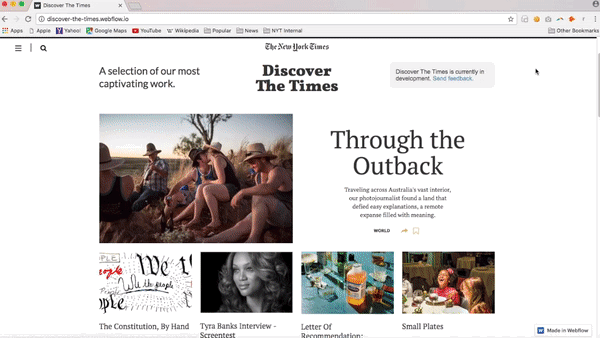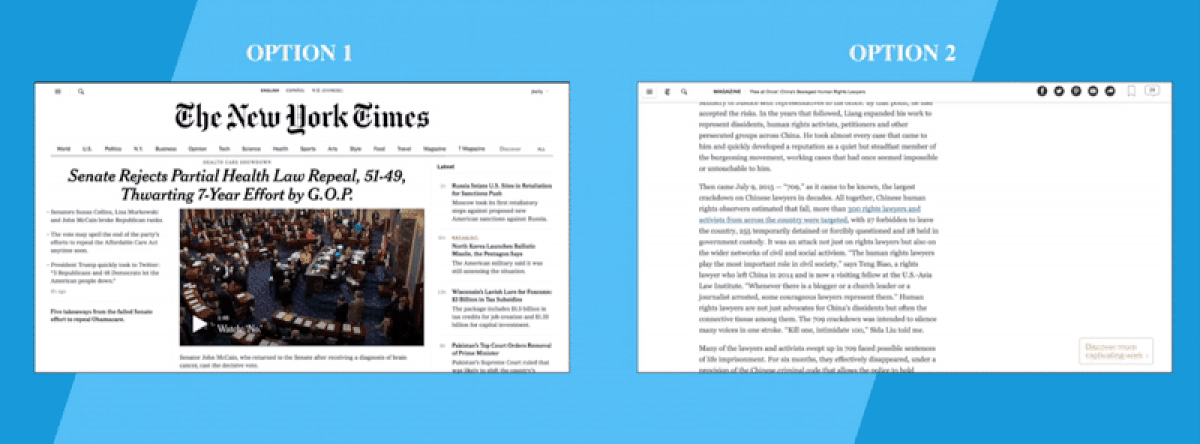Discover The Times addresses user engagement issues by compiling a single page to showcase compelling feature content published by The New York Times.
Problems Our Product Addresses
Based on user research conducted for this project, we found that young professionals (ages 18–24) oftentimes see The Times as a place for an intense, academic, and potentially overwhelming reading experience. The Times can be unappealing for young people because of what some described as this intense, academic experience.
At the same time, we found that many young readers of The Times do not explore many pieces of content; oftentimes, they will read one or two articles before leaving the site — not to return for another visit for quite some time. The Times struggles to retain many young users for more than a short period of time.
Research shows that many young people are inclined to read more “soft news” than “hard news.” In other words, evergreen content — features, long-form creative or interactive pieces, videos or multimedia, culture pieces is often more appealing. Much of the content on the front page of The Times is considered the most important news, but this important news is not always the most appealing to young readers. The Times creates many excellent pieces of evergreen content, but the content is not as accessible as it should be.
Our Solution: Discover The Times
Discover The Times is a single page that showcases some of the beautiful and compelling feature content that The New York Times publishes. The focus isn’t on hard breaking news but rather focuses on curated mix of feature articles, interactive journalism, 360-degree videos, podcasts, long-form pieces, photo galleries, interviews, and reviews.
Product Details
Access / Entry to Discover the Times
In order for Discover the Times to succeed, a key element is ensuring readers can easily access the Discover page (that they can discover the Discover page, one might say…).
On the desktop platform, we explored two options. The most realistic option is to add a separate tab on the homepage navigation bar (shown as “Option 1” below). The second and most practical and effective option is a constant floating access button (shown as “Option 2” below). This would also encourage readers to stay in a constant loop of discovering content, ensuring that they read more than just one article during their visits to The Times.
On the mobile platform, we plan to include a card similar to what The Daily currently employs. Similarly, we want to reach users who are on social media, so we plan to implement a button on those articles and posts on social media.
Content Curation
What distinguishes Discover the Times is the content it features. It is not a trending page, nor is it a multimedia page, nor is it a youth page. It is a page with selected evergreen content — content that The Times prides itself on. This content is selected from a few categories:
Featured
Page-turners (long-form pieces)
Popular on Social
What to Watch
Lifestyle Guides
Podcasts
Editor’s Picks
Content for the prototype was hand-selected from these categories. However, in the future this would be automated so that the page would be auto-populated with new pieces each morning.
Monetization
Digital advertising potential is increasing within The New York Times. Most recently in the second quarter this year, digital advertising revenue increased 23 percent to $55 million.
Discover the Times would add value to increasing the digital advertising revenue with The Times as a whole. This would be done in three ways:
Section Front Advertisements:These advertisements would appear at the top of the Discover page, similar to the primary ad that appears on the top of The New York Times front page.
Articles in Collection: By resurfacing evergreen content and featuring curated content, Discover the Times would drive more readers to these articles and pieces of content — of which each have advertisements and thus would increase impressions.
Newsletter: Readers can opt in to receive Discover the Times in newsletter form in their inbox. Advertising potential in the newsletter would ad to increased revenue of Discover the Times.
After meeting with several advertising experts within The Times, below is an estimated amount of revenue Discover the Times could expect to bring in:
Future Features
To take the product a step further, there are a few features that could be pursued after deployment of Discover the Times:
Personalization and Retention/Growth of Subscribers: Right now we focus on a carefully curated display of evergreen content. However, there is possibility for personalized evergreen content. This could work by the user originally selecting preferences and topics, and by consistently being able to press a thumbs up or thumbs down on Discover pieces they read. The algorithm that curates content could then learn what the user likes, providing content directly geared to that person. The personalization feature would only be available to subscribers of The New York Times, serving as a way to both retain subscribers as well as encourage casual readers to purchase a digital subscription.
Contribution to Other Times Initiatives: Based on a meeting we had with The Times’s Snapchat Discover team (who prepares and adapts content for Snapchat Discover), they like to feature evergreen content. In the future, we could see content being cross-applied between both platforms with both Snapchat Discover and Discover the Times working together to curate content. Or, data collected from Discover the Times (which has several slots for content each day) could assist in choosing which feature pieces with the most views could be selected for Snapchat Discover in the future (which has more limited slots for content each day).
Self-Sustainability: The goal of Discover the Times is to make it a page that can be auto-populated with content from the categories listed above, rather than having a team hand-picking content (hand-picked content would be selected by the algorithm from Editor’s Picks!). In the future, it would be critical to test the best ways of doing this. For example, it could be worth implementing an ‘evergreen’ tag to tag articles within Scoop.
With Discover the Times, we want to encourage readers — particularly young readers and unengaged readers — to get lost in the content The Times has to offer. We hope to empower people to lose track of time without wasting time.
Intern project by Aana Bansal, Akshay Patel, Annie Schugart, Benjamin Williams, Bridgette Tolbert, Delaney Haynes, Fatima Chaudhry, Julian Kelly and Riley Shanahan. Summer interns at The New York Times were given each Friday to collaborate within a group to research, test, brainstorm, and develop a new product for The New York Times that addresses a problem The Times faces.







